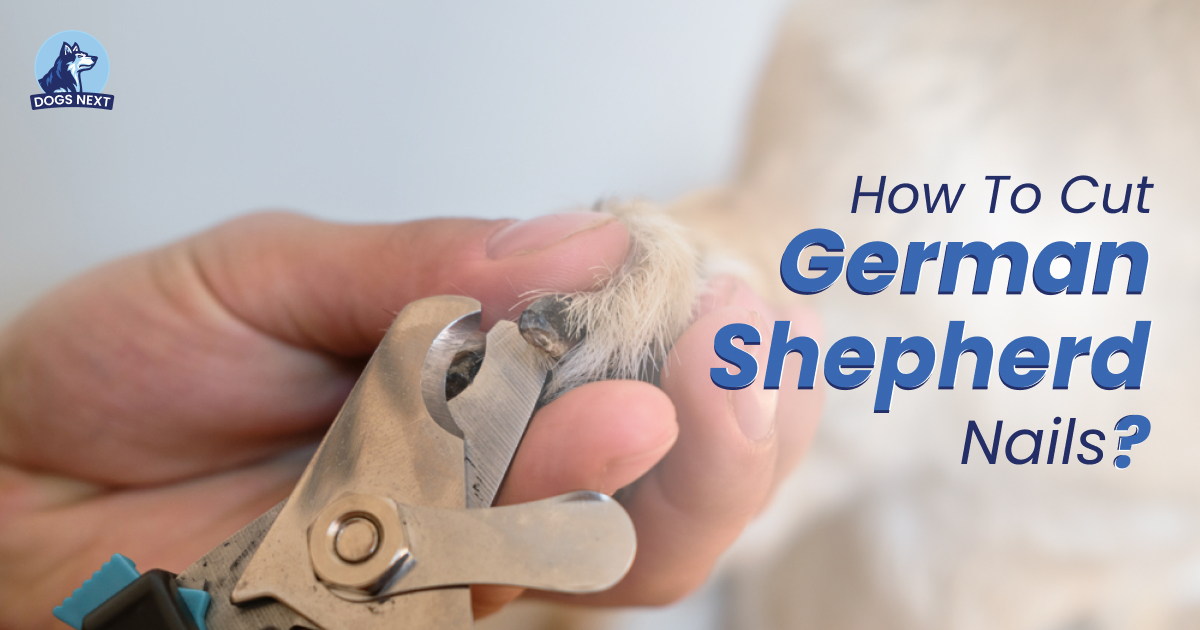Trimming your German Shepherd’s nails is an essential part of their grooming routine, but it can be a daunting task. The best way to start trimming GSD nails is by gradually introducing your dog to the process.
Begin by handling their paws regularly and offering positive reinforcement, such as treats or praise. When it’s time to trim their nails, use sharp, high-quality clippers designed for dog nails and avoid cutting the quick, which is the pink part of the nail that contains blood vessels and nerves.
If you do accidentally cut the quick, use styptic powder to stop the bleeding. Regular nail trimming and maintaining a healthy diet and exercise routine will ensure your German Shepherd’s paws stay healthy and strong. This article will teach you the best way to trim your German Shepherd’s nails and provide grooming tips for their care.
Table of Contents
When Should You Cut German Shepherds Nails
You need to cut your GSD’s nails at the correct time if you want to avoid nail clipping injuries and excessively long nails.
You don’t always sit on your lap with a German Shepherd dog! Thus, your dog’s paws may not be visible to you as frequently as those of a smaller dog. Your German Shepherd’s nails should be trimmed if the following indicators are present.
It is recommended to cut the nails of German Shepherds at the following times:
- A curl or ground contact occurs
- There is a clicking sound coming from the floor due to the nails
- Your dog is experiencing discomfort or pain while walking or standing as a result of them
- You or your furniture are scratched by your dog’s nails
- Dog shows or competitions are on your mind
- Your dog is getting used to nail trimming, so you are introducing it for the first time.
Dogs’ lifestyles, activity levels, and the surfaces they walk on may influence how often they need their nails trimmed. It is important to trim your nails regularly to prevent a range of nasty ailments, such as discomfort and pain.
Is it Necessary to Trim the Nails of a German Shepherd?
German Shepherds need their nails trimmed regularly to avoid injuries. There is a possibility that you might cause continuous bleeding of your toenail if you attempt to cut too much of the toenail.
German Shepherds’ nails should be cut for a number of reasons:
- This will prevent them from slipping while walking.
- To make walking more comfortable for them.
- Prevents sprains and injuries to the paws caused by awkward postures.
- Preventing infection and pain caused by overgrown nails.
- You and your wooden floor will be protected from scratches!
The paws of your GSD don’t need to be checked out weekly. As your dog’s nails grow, you should trim them as and when necessary, based on the estimated length of their growth. Monthly toenail checks and cutting are usually recommended.
The Unique Characteristics of a German Shepherd’s Paw
There should be a lot of roundness and strength in the paws of a German Shepherd. A GSD has a heavy front end, as is the case with many dogs.
A German Shepherd’s front paws are slightly larger than its rear feet since 60% of its body weight lies in front of the last rib.
Due to the fact that German Shepherds receive 70% of their power from their hind ends, their rear claws tend to be worn down more quickly than their front claws.
Claws are shaped from the tips of a dog’s paw bones. There are three bones in each phalange, like your fingers and toes. There’s a claw base embedded around the tip of the last bone segment.
In addition to picturing a small bone with a crescent-shaped tip at tip, you may view the dog’s claw in this way. It is the fibrous protein keratin that is responsible for the hardness of dog claws.
The cuticle of a dog’s claw is similar to the one on the outside of your nails. In terms of nail shape, there is a significant difference. It is difficult to tell where to cut the German shepherd’s claws because they tend to have black nails.
Tips for Properly Maintaining Long Nails through Grooming
When you hear your dog’s nails clicking on the hardwood floor, you can tell if their nails are too long.
It should be noted, however, that there is some controversy regarding this issue; some believe hearing a clicking sound means it is time to trim your dog’s nails right away. Those who have hard floors say you don’t actually need to trim your dog’s nails if they have a hard floor since it tends to keep their nails short enough.
The dog’s nails should not be allowed to grow too long regardless of your personal preference. Your dog can jump on them or accidentally scratch them — but they are actually dangerous for your dog, too.
They can scratch the floor and cause a hazard to those around them when your dog jumps on them. The reasons for this can be summed up as follows.
Long nails are dangerous for a number of reasons
- Leaving a canine nail to grow too long can lead to it catching on objects, tearing, and potentially causing bleeding and an increased risk of infection. In German Shepherds, who are highly active, there is an even greater risk of nail tearing due to their activity level. This can make them more vulnerable to infections.
- Additionally, when nails are too long, they may catch on things and tear, causing discomfort and potential injury. To prevent these issues, it is important to keep your dog’s nails trimmed to an appropriate length.
- As a result of long nails, the dog’s feet are not aligned properly. As a result, weight distribution can become a problem and posture can become a problem. Dogs may also develop splayed toes because of this.
- The toes of dogs with long nails are more sensitive to pain than those with short nails. They may become overly cautious about playing with other dogs or being active as a result.
Proper Grooming Techniques for Keeping Nails Short
It is still possible to keep the paws of your German Shepherd in good health even if their nails are short:
- Keeping your dog’s paws and nails clean will help prevent injuries, infections, and overgrowth.
- When you’re done walking or playing, wipe their paws down with a damp cloth.
- Make sure their nails are smooth by using a nail file or Dremel tool.
- Maintain paw pads’ softness and hydration with paw balm or moisturizer.
- Positive reinforcement, like treats or praise, can help your dog feel more comfortable about nail trimming.
- When you are concerned about the health or grooming routine of your dog’s paws, it is advisable that you consult a veterinarian or a professional groomer.
Average Nail Sizes by Dog Breed
| Dog Breed | Average Nail Size |
| German Shepherd | Medium to Large |
| Chihuahua | Small |
| Poodle | Small to Medium |
| Labrador Retriever | Medium |
| Great Dane | Large |
| Saint Bernard | Extra Large |
Why Trimming German Shepherd Nails is Important
The responsibility of caring for your dog and ensuring his health is part of your responsibility as an owner. Your German shepherd puppy’s nails should be regularly trimmed as a way to achieve this.
Keeping your pet’s nails trimmed is important for several reasons.
In addition to being painful and injurious, overgrown nails may also set the stage for infection. If you cut up your long nails on something, they can easily wear and tear.
There can be complications as the dog’s posture and weight distribution are impacted when the nails are too long, as long nails can make an unpleasant sound (noise).
An overgrown nail can restrict your pup’s movement, resulting in pain and inability to go about his daily activities. In addition to experiencing pain around his nails, your dog may also become inactive and unwilling to exercise and walk regularly.
When your dog walks or runs, untrimmed nails can cause him to slip and fall. German shepherd dogs benefit greatly from having their nails trimmed.
Different Varieties of Nail Clippers for Trimming Nails
- Scissor-type – Puppies will love it, but adults may not have the strength to handle it
- Plier-style – Easily gripped
- Guillotine – If your dog moves around a lot, you may not be able to place it well; black nails may not work well with this method
- Grinder – As the nail is filed, a Dremel tool gradually shortens it. The tools can be used to take care of nails, either as a primary nail care method or after clippers have been used to trim your nails. There must be a steady hand and proficiency on the part of the handler.
Step-by-Step Instructions on Cutting Your German Shepherd’s Nails: Nail Tips
Dogs’ nails are very sensitive and when it comes to trimming puppies’ nails, you may feel overwhelmed, but it doesn’t have to be. Typically, there are two types of nails, Dark nails, and white nails, Dark nails can be challenging to trim since it’s difficult to locate the quickly due to their color. In contrast, white nails are easier to trim because the quick is more visible owing to their lighter color getting started is as easy as following these tips.
1. Familiarize your dog with the clippers – You should start doing this as early as possible. Make your GSD feel positive when he explores and sniffs the clippers – reward him with a treat. The first step to preparing your pup for the handling of his paws is to get used to it.
2. Call your German Shepherd – We are starting here. If you want to talk to your doggo, you can walk up to him, but it’s a better idea to sit down and call him from a comfortable position. A treat will work to entice him over.
3. Be calm and help him become calm – The dog might need to be worn out if he is in an energetic state. Having to wrestle with a GSD over their desire to have their nails trimmed is the last thing you want to experience.
4. Get him in a comfortable spot to lend his paw – It is important to take into account his comfort as well as your own. Please refrain from trimming his nails on a chair. Make sure he is seated properly on a couch. When grooming, you can keep him calm and entertained by using a lick mat such as the Aquapaw that is filled with peanut butter.
5. Take his paw and extend one claw at a time – In order to avoid accidentally cutting the quick of a GSD, the claws should be clipped. By stretching your toes out you can stretch out your nails and make trimming the overgrown edges easier, resulting in shorter nails.
6. Look for the white portion towards the tip of the claw – Toes have pinkish and white areas, which can be distinguished when you extend them. Quicks are small pinkish beans that are found inside nails. This white area tends to be where the area is overgrown and is usually found towards the end.
7. Remove as little as possible – Try to clip as little as possible, cut at a 45-degree angle, and try to follow the natural shape of the nail as much as possible. If you clip more, you will end up damaging the nail.
8. Let the claw snap back and check if it reaches the paw pad – Once you have clipped the nail, it is important to determine whether it needs to be trimmed again. If you need to do two attempts to clip a claw, clip a small enough length. If you do this, you can help prevent the quick from being accidentally cut.
German Shepherd Nail Cutting Tools
German Shepherd nails can be cut using the following tools:
- Cutting tools (such as scissors, pliers, grinders, or guillotine)
- Styptic Powder
- Muzzles or harnesses
Why German Shepherds Dislike Feet Touching and Nail Trimming?
Why does your dog dislike nail trimming? There are several reasons:
- Discomfort or pain: The quick in your dog’s nail may feel painful or uncomfortable if you have accidentally cut it before. If you accidentally cut the quick, your dog may associate nail trimming with pain or discomfort in the future.
- Associative negatives: When your dog experiences a bad experience with nail trimming, for instance, when they feel restrained or held down forcefully, they are likely to develop some form of fear or aversion toward it in the future.
- Familiarity deficit: You should make sure your dog is comfortable and relaxed when you handle his paws or trim his nails if he is not used to it.
- Fear or anxiety: The sound of nail clippers or the sensation of being trimmed may cause anxiety or fear in some dogs.
- Issues with your health: Nail trimming can be painful for dogs with arthritis, infections, or injuries that affect their nails or paws.
A dog that shows signs of discomfort or aversion should be treated with patience and care when they need its nails trimmed. You should gradually introduce them to the process, make sure they are positively reprimanded as they go along, and you may need to seek advice from a veterinarian or professional groomer if necessary.
Why should you avoid cutting the quick?
Blood vessels and nerves are both found in the quick of a German Shepherd. What is the experience of having a hangnail like?
Imagine that you are trying to pull out that hangnail from your dog’s nose, and it hurts as much as it hurts you when you “quick” her.
Furthermore, even if you just nick the cuticle of the nail, you can expect the nail to bleed profusely.
German Shepherd Nails Bleeding After Cutting: What to Do?
You should follow these steps!
- The affected toenail should be pressured.
- Stop bleeding by applying styptic powder to the wound.
- Applied styptic powder to a bleeding nail may be necessary if the bleeding persists.
- To stop bleeding from your nails immediately, follow these steps.
- Do you continue to bleed? If you need help, visit your veterinarian.
Bleeding prevention powders
- Antiseptic powder – In order to stop bleeding from a shifted nail, you should use Qwikstop or similar commercial products on the market.
- Cornstarch – Styptics work better than home remedies for bleeding claws, but not as well as most home solutions.
Teabag – You can stop minor bleeding with a teabag if it is wet.
Frequently Asked Questions
Q: German Shepherds’ nails are cut to what length?
Ans: Put the nail in the right place for your dog. Make a 2 – 3 millimeter cut from the bottom of one toenail by lightly grasping it with your fingers and pulling the hair back.
Q: Do German Shepherds have long toenails?
Ans: To leave the quick as intact as possible, it is recommended to cut about 2mm away from it. The quick of a dog may be difficult to see if it has black or dark claws, so nail trimming may be harder for such dogs
Q: How do you cut a dog’s nails?
Ans: The angle is 45 degrees
Dogs should not be able to see the cutting blade when it is closest to them. Make sure the nail isn’t too short, or you may have bleeding. A 45-degree angle should be used when cutting nails.
Conclusions
In conclusion, cutting your German Shepherd’s nails can seem like a daunting task, but with the right tools, techniques, and patience, it can be a manageable part of your dog’s grooming routine.
Starting by gradually introducing your dog to the process and using positive reinforcement can help make the experience less stressful for both you and your pet. Remember to use sharp, high-quality clippers designed for dog nails and avoid cutting the quickly to prevent pain or discomfort.
Regularly inspecting your dog’s paws and nails for signs of injury, infection, or overgrowth is also important for maintaining their paw health. If your dog shows signs of discomfort or aversion to nail trimming, consult with a veterinarian or professional groomer for guidance.
By following these tips and techniques, you can ensure your German Shepherd’s nails stay healthy, strong, and well-maintained.

I’m David, an expert contributor and writer, with two furry friends of my own, I know the challenges of raising and caring for dogs. From training to nutrition and health, my goal is to provide valuable insights and advice to help create strong bonds and happy, healthy lives. Find me in Twitter.




